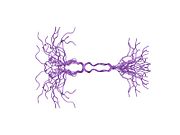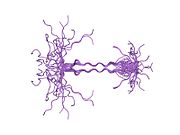Syndecan-4
Template:PBB Syndecan-4 is a protein that in humans is encoded by the SDC4 gene.[1][2] Syndecan-4 is one of the four vertebrate syndecans and has a molecular weight of ~20 kDa. Syndecans are the best-characterized plasma membrane proteoglycans. Their intracellular domain of membrane-spanning core protein interacts with actin cytoskeleton and signaling molecules in the cell cortex. Syndecans are normally found on the cell surface of fibroblasts and epithelial cells. Syndecans interact with fibronectin on the cell surface, cytoskeletal and signaling proteins inside the cell to modulate the function of integrin in cell-matrix adhesion. Also, syndecans bind to FGFs and bring them to the FGF receptor on the same cell. As a co-receptor or regulator, mutated certain proteoglycans could cause severe developmental defects, like disordered distribution or inactivation of signaling molecules.
Syndecans have similar structural features:
- Attach to heparan sulfate chains – interacting factors (e.g. Matrix molecules, growth factors, and enzymes)
- Chondroitin sulfate chain
- Transmembrane domain – self-association
- C1 domain – actin-association cytoskeleton
- Variable domain – syndecan-specific
- C2 domain – attach to PDZ proteins
Syndecans normally form homodimers or multimers. Their biological function includes cell growth regulation, differentiation, and adhesion. Syndecan-4 has more widespread distribution than other syndecans and it is the only syndecan that has been found consistently in focal adhesions.[3]
Gene
Syndecan-4 is also called ryudocan or amphiglycan. It is found on chromosome 20, while a pseudogene has been found on chromosome 22.[4] Syndecan-4 is one of the four vertebrate syndecans and has a molecular weight of ~20 kDa. It has more widespread distribution than other syndecans, and it is the only syndecan that has been found consistently in focal adhesions.[5]
Function
Syndecan-4 is a transmembrane (type I) heparan sulfate proteoglycan that functions as a receptor in intracellular signaling. The protein is found as a homodimer and is a member of the syndecan proteoglycan family.[4] Syndecan-4 interacts with extracellular matrix, anticoagulants, and growth-factors. It also regulates the actin cytoskeleton, cell adhesion, and cell migration.[6]
Syndecan-4 activates protein kinase C (PKC), an enzyme involved in signal transduction.[7] The variable domain of syndecan-4 could be a site of self-association. The degree of oligomerization correlates with the activity of kinases, so the degree of clustering of syndecan-4 correlates to PKC activity.[8] Syndecan-4 also binds to phosphatidylinositol (4,5)-bisphosphate (PIP2) through the variable domain and increases PKC activity ten-fold.[9]
Syndecan-4 is also a regulator of fibroblast growth factor-2 (FGF-2) signaling. Syndecan-4 binds to FGF and mediates interaction with the FGF receptor.[10] Because the tight correlation between syndecan-4 and growth factors, the efficiency of angiogenic therapies have been thought to relate to syndecan-4. Growth factor signaling may be disrupted by changes in syndecan-4 expression.[11][12][13] The cellular uptake, trafficking, and nuclear localization of FGF-2 could be increased by co-delivery of syndecan-4 proteoliposomes. These alterations should be considered in FGF-2-based therapies.[14]
Syndecan-4 is also associated with the healing process. Lack of Sdc4 gene causes delayed wound healing in mice. This delay may be due to compromised fibroblast motility.[15]
Clinical significance
Osteoarthritis
Syndecan-4 is upregulated in osteoarthritis and inhibition of syndecan-4 reduces cartilage destruction in mouse models of OA.[16]
See Sindecán-4 at the Spanish Wikipedia
References
- ^ Kojima T, Inazawa J, Takamatsu J, Rosenberg RD, Saito H (Mar 1993). "Human ryudocan core protein: molecular cloning and characterization of the cDNA, and chromosomal localization of the gene". Biochem Biophys Res Commun. 190 (3): 814–22. doi:10.1006/bbrc.1993.1122. PMID 7916598.
{{cite journal}}: CS1 maint: multiple names: authors list (link) - ^ David G, van der Schueren B, Marynen P, Cassiman JJ, van den Berghe H (Sep 1992). "Molecular cloning of amphiglycan, a novel integral membrane heparan sulfate proteoglycan expressed by epithelial and fibroblastic cells". J Cell Biol. 118 (4): 961–9. doi:10.1083/jcb.118.4.961. PMC 2289559. PMID 1500433.
{{cite journal}}: CS1 maint: multiple names: authors list (link) - ^ Woods A, Couchman JR (1994). "Syndecan 4 heparan sulfate proteoglycan is a selectively enriched and widespread focal adhesion component". Mol Biol Cell. 5 (2): 183–192. doi:10.1091/mbc.5.2.183. PMC 301024. PMID 8019004.
- ^ a b "Entrez Gene: SDC4 syndecan 4".
- ^ Woods A, Couchman JR (February 1994). "Syndecan 4 heparan sulfate proteoglycan is a selectively enriched and widespread focal adhesion component". Mol. Biol. Cell. 5 (2): 183–92. doi:10.1091/mbc.5.2.183. PMC 301024. PMID 8019004.
- ^ Woods A, Couchman JR (May 1998). "Syndecans: synergistic activators of cell adhesion". Trends Cell Biol. 8 (5): 189–92. doi:10.1016/S0962-8924(98)01244-6. PMID 9695837.
- ^ Hyatt SL, Klauck T, Jaken S (1990). "Protein kinase C is localized in focal contacts of normal but not transformed fibroblasts". Mol. Carcinog. 3 (2): 45–53. doi:10.1002/mc.2940030202. PMID 2161238.
{{cite journal}}: CS1 maint: multiple names: authors list (link) - ^ Grootjans JJ, Zimmermann P, Reekmans G, Smets A, Degeest G, Dürr J, David G (December 1997). "Syntenin, a PDZ protein that binds syndecan cytoplasmic domains". Proc. Natl. Acad. Sci. U.S.A. 94 (25): 13683–8. Bibcode:1997PNAS...9413683G. doi:10.1073/pnas.94.25.13683. PMC 28366. PMID 9391086.
{{cite journal}}: CS1 maint: multiple names: authors list (link) - ^ Oh ES, Woods A, Couchman JR (May 1997). "Multimerization of the cytoplasmic domain of syndecan-4 is required for its ability to activate protein kinase C". J. Biol. Chem. 272 (18): 11805–11. doi:10.1074/jbc.272.18.11805. PMID 9115237.
{{cite journal}}: CS1 maint: multiple names: authors list (link) CS1 maint: unflagged free DOI (link) - ^ Chua CC, Rahimi N, Forsten-Williams K, Nugent MA (February 2004). "Heparan sulfate proteoglycans function as receptors for fibroblast growth factor-2 activation of extracellular signal-regulated kinases 1 and 2". Circ. Res. 94 (3): 316–23. doi:10.1161/01.RES.0000112965.70691.AC. PMID 14684627.
{{cite journal}}: CS1 maint: multiple names: authors list (link) - ^ Bortoff KD, Wagner WD (February 2005). "Reduced syndecan-4 expression in arterial smooth muscle cells with enhanced proliferation". Exp. Mol. Pathol. 78 (1): 10–6. doi:10.1016/j.yexmp.2004.08.010. PMID 15596055.
- ^ Neelapu SS, Gause BL, Harvey L, Lee ST, Frye AR, Horton J, Robb RJ, Popescu MC, Kwak LW (June 2007). "A novel proteoliposomal vaccine induces antitumor immunity against follicular lymphoma". Blood. 109 (12): 5160–3. doi:10.1182/blood-2006-12-063594. PMC 1941785. PMID 17339422.
{{cite journal}}: CS1 maint: multiple names: authors list (link) - ^ Olsson U, Bondjers G, Camejo G (March 1999). "Fatty acids modulate the composition of extracellular matrix in cultured human arterial smooth muscle cells by altering the expression of genes for proteoglycan core proteins". Diabetes. 48 (3): 616–22. doi:10.2337/diabetes.48.3.616. PMID 10078565.
{{cite journal}}: CS1 maint: multiple names: authors list (link) - ^ Jang E, Albadawi H, Watkins MT, Edelman ER, Baker AB (January 2012). "Syndecan-4 proteoliposomes enhance fibroblast growth factor-2 (FGF-2)-induced proliferation, migration, and neovascularization of ischemic muscle". Proc. Natl. Acad. Sci. U.S.A. 109 (5): 1679–84. Bibcode:2012PNAS..109.1679J. doi:10.1073/pnas.1117885109. PMC 3277125. PMID 22307630.
{{cite journal}}: CS1 maint: multiple names: authors list (link) - ^ Echtermeyer F, Streit M, Wilcox-Adelman S, Saoncella S, Denhez F, Detmar M, Goetinck P (January 2001). "Delayed wound repair and impaired angiogenesis in mice lacking syndecan-4". J. Clin. Invest. 107 (2): R9–R14. doi:10.1172/JCI10559. PMC 199172. PMID 11160142.
{{cite journal}}: CS1 maint: multiple names: authors list (link) - ^ Hass MJ (Sep 2009). "SDC4: OA joint effort". SciBX. 2 (34). doi:10.1038/scibx.2009.1297.
Further reading
- Bass MD, Humphries MJ (2002). "Cytoplasmic interactions of syndecan-4 orchestrate adhesion receptor and growth factor receptor signalling". Biochem. J. 368 (Pt 1): 1–15. doi:10.1042/BJ20021228. PMC 1222989. PMID 12241528.
- Yu H, Humphries DE, Watkins M, Karlinsky JB (1995). "Molecular cloning of the human ryudocan promoter". Biochem. Biophys. Res. Commun. 212 (3): 1139–44. doi:10.1006/bbrc.1995.2087. PMID 7626103.
{{cite journal}}: CS1 maint: multiple names: authors list (link) - Barillari G, Gendelman R, Gallo RC, Ensoli B (1993). "The Tat protein of human immunodeficiency virus type 1, a growth factor for AIDS Kaposi sarcoma and cytokine-activated vascular cells, induces adhesion of the same cell types by using integrin receptors recognizing the RGD amino acid sequence". Proc. Natl. Acad. Sci. U.S.A. 90 (17): 7941–5. Bibcode:1993PNAS...90.7941B. doi:10.1073/pnas.90.17.7941. PMC 47263. PMID 7690138.
{{cite journal}}: CS1 maint: multiple names: authors list (link) - Woods A, Couchman JR (1994). "Syndecan 4 heparan sulfate proteoglycan is a selectively enriched and widespread focal adhesion component". Mol. Biol. Cell. 5 (2): 183–92. doi:10.1091/mbc.5.2.183. PMC 301024. PMID 8019004.
- Maruyama K, Sugano S (1994). "Oligo-capping: a simple method to replace the cap structure of eukaryotic mRNAs with oligoribonucleotides". Gene. 138 (1–2): 171–4. doi:10.1016/0378-1119(94)90802-8. PMID 8125298.
- Albini A, Benelli R, Presta M, Rusnati M, Ziche M, Rubartelli A, Paglialunga G, Bussolino F, Noonan D (1996). "HIV-tat protein is a heparin-binding angiogenic growth factor". Oncogene. 12 (2): 289–97. PMID 8570206.
{{cite journal}}: CS1 maint: multiple names: authors list (link) - Kojima T, Katsumi A, Yamazaki T, Muramatsu T, Nagasaka T, Ohsumi K, Saito H (1996). "Human ryudocan from endothelium-like cells binds basic fibroblast growth factor, midkine, and tissue factor pathway inhibitor". J. Biol. Chem. 271 (10): 5914–20. doi:10.1074/jbc.271.10.5914. PMID 8621465.
{{cite journal}}: CS1 maint: multiple names: authors list (link) CS1 maint: unflagged free DOI (link) - Takagi A, Kojima T, Tsuzuki S, Katsumi A, Yamazaki T, Sugiura I, Hamaguchi M, Saito H (1997). "Structural organization and promoter activity of the human ryudocan gene". J. Biochem. 119 (5): 979–84. doi:10.1093/oxfordjournals.jbchem.a021338. PMID 8797100.
{{cite journal}}: CS1 maint: multiple names: authors list (link) - Rusnati M, Coltrini D, Oreste P, Zoppetti G, Albini A, Noonan D, d'Adda di Fagagna F, Giacca M, Presta M' (1997). "Interaction of HIV-1 Tat protein with heparin. Role of the backbone structure, sulfation, and size". J. Biol. Chem. 272 (17): 11313–20. doi:10.1074/jbc.272.17.11313. PMID 9111037.
{{cite journal}}: CS1 maint: multiple names: authors list (link) CS1 maint: unflagged free DOI (link) - Chang HC, Samaniego F, Nair BC, Buonaguro L, Ensoli B (1997). "HIV-1 Tat protein exits from cells via a leaderless secretory pathway and binds to extracellular matrix-associated heparan sulfate proteoglycans through its basic region". AIDS. 11 (12): 1421–31. doi:10.1097/00002030-199712000-00006. PMID 9342064.
{{cite journal}}: CS1 maint: multiple names: authors list (link) - Suzuki Y, Yoshitomo-Nakagawa K, Maruyama K, Suyama A, Sugano S (1997). "Construction and characterization of a full length-enriched and a 5'-end-enriched cDNA library". Gene. 200 (1–2): 149–56. doi:10.1016/S0378-1119(97)00411-3. PMID 9373149.
{{cite journal}}: CS1 maint: multiple names: authors list (link) - Horowitz A, Simons M (1998). "Regulation of syndecan-4 phosphorylation in vivo". J. Biol. Chem. 273 (18): 10914–8. doi:10.1074/jbc.273.18.10914. PMID 9556568.
{{cite journal}}: CS1 maint: unflagged free DOI (link) - Lee D, Oh ES, Woods A, Couchman JR, Lee W (1998). "Solution structure of a syndecan-4 cytoplasmic domain and its interaction with phosphatidylinositol 4,5-bisphosphate". J. Biol. Chem. 273 (21): 13022–9. doi:10.1074/jbc.273.21.13022. PMID 9582338.
{{cite journal}}: CS1 maint: multiple names: authors list (link) CS1 maint: unflagged free DOI (link) - Cohen AR, Woods DF, Marfatia SM, Walther Z, Chishti AH, Anderson JM (1998). "Human CASK/LIN-2 Binds Syndecan-2 and Protein 4.1 and Localizes to the Basolateral Membrane of Epithelial Cells". J. Cell Biol. 142 (1): 129–38. doi:10.1083/jcb.142.1.129. PMC 2133028. PMID 9660868.
{{cite journal}}: CS1 maint: multiple names: authors list (link) - Rusnati M, Tulipano G, Spillmann D, Tanghetti E, Oreste P, Zoppetti G, Giacca M, Presta M (1999). "Multiple interactions of HIV-I Tat protein with size-defined heparin oligosaccharides". J. Biol. Chem. 274 (40): 28198–205. doi:10.1074/jbc.274.40.28198. PMID 10497173.
{{cite journal}}: CS1 maint: multiple names: authors list (link) CS1 maint: unflagged free DOI (link) - Gao Y, Li M, Chen W, Simons M (2000). "Synectin, syndecan-4 cytoplasmic domain binding PDZ protein, inhibits cell migration". J. Cell. Physiol. 184 (3): 373–9. doi:10.1002/1097-4652(200009)184:3<373::AID-JCP12>3.0.CO;2-I. PMID 10911369.
{{cite journal}}: CS1 maint: multiple names: authors list (link) - Tyagi M, Rusnati M, Presta M, Giacca M (2001). "Internalization of HIV-1 tat requires cell surface heparan sulfate proteoglycans". J. Biol. Chem. 276 (5): 3254–61. doi:10.1074/jbc.M006701200. PMID 11024024.
{{cite journal}}: CS1 maint: multiple names: authors list (link) CS1 maint: unflagged free DOI (link) - Shin J, Lee W, Lee D, Koo BK, Han I, Lim Y, Woods A, Couchman JR, Oh ES (2001). "Solution structure of the dimeric cytoplasmic domain of syndecan-4". Biochemistry. 40 (29): 8471–8. doi:10.1021/bi002750r. PMID 11456484.
{{cite journal}}: CS1 maint: multiple names: authors list (link)


